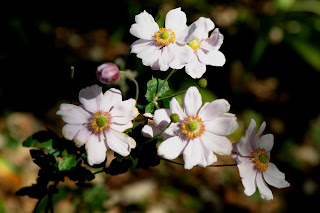I looked back through unutilized images from the 2010 growing season and decided to share them as a reflection of this great growing season:

Hard to believe there was still snow on the ground on March 22nd when I took this picture from the terrace of the Visitor Center. Just two days later the growing season began! We all know the Kansas City climate has wild mood swings...

Within two weeks the Daffodils were in full bloom: this is Cum Laude Daffodil (Narcissus split corona division) blooming on the Island Garden in early April.

Though winter was long and dragged on, Redbuds (Cercis canadensis) were in full bloom right on schedule in mid-April. This shot was taken in the Perennial Garden and note the floriferous drifts of daffodils beneath them.

The Apples (Malus pumila) in the Heartland Harvest Garden were in full bloom on April 16th. The trees have since grown 2 to 4 more feet!

Our last Kwanzan Flowering Cherry (Prunus serrulata) also bloomed this spring but this would prove its last -- the incredible rainfall actually drowned this 15 year old established tree. We will have to try again in a site that will drain better.

Indian Paintbrushes (Castilleja coccinea) bloomed in the prairie planting in the Heartland Harvest Garden and were screaming scarlet. These plants originated from seed collected off our friend Ona Gieschen's native hay prairie outside Sedalia.

The Whitaker sculptures were fun in the spring winds and this piece on the Island Garden was a favorite. The Tea Flowering Crabapples (Malus hupehensis) on either side were in full bloom (as were all the crabapples on the Island Garden) and echoed beautifully the white puffy clouds overhead.

The greens of May in the prairie meadow show a large clump of Gama Grass (Tripsacum dactyloides) right of the path already with its turkey-foot-shaped blooms. This inspires me to take this shot now with billowing grasses in rich fall attire.

Our large Golden Barrel Cactus and American Agave loved the warm growing season, nearly being swallowed by a wayward morning glory towards the end of the growing season. These frost hardy cacti can stay out late but spend the winter in our cool greenhouse for safe keeping and use in 2011.

June 18th the Hyssop (Hyssopus officinalis) decorated the rows of grapes as their companion. There blossoms are backlit by the morning light of the Vineyard.

Native Prairie Rose (Rosa setigera) always shines with its pink flowers around the summer solstice. It's a challenge to photograph in the intense light of its season. We have it planted around the outer edge of the Apple Celebration Court as a companion planting to the Apple trees.

The greens of mid-summer are contrasted with white variegated leaves in this planting near the Chapel's trolley stop. The variegated foliage is from the Floating Clouds Redbud and it contrasts nicely with the bold foliage of Oakleaf Hydrangeas on either side.

At Booms and Blooms time the Perennial Garden is exuberant with daylilies, hardy hibiscus, purple coneflowers and other vivacious perennials in bloom. The tapestry hedge also is really filling in and got a good trim this June to keep its height maintained around 8 feet.

The lush wet season allowed the Butterburs (Petasites japonica) in the Rock & Waterfall Garden to reach huge proportions. Here they are wet with rain while Incrediball Hydrangeas (Hydrangea arborescens 'Abetwo') bloom behind them. This is only the second year for our Incrediball Hydrangeas and once they are fully established they will have immense flower heads on sturdy stems.

The intensely fragrant flowers of Ruby Spice Summersweet (Clethra alnifolia) caught the attention of many visitors to the Island Garden. This Plant of Merit makes a great summer blooming shrub and thrives with extra moisture.

This July shot of the Island Garden pools almost looks laughable because shortly after all these plants mushroomed in size and abundant flowers! The upright plant left is a Red-stemmed Thalia, the right one is Papyrus while a tropical waterlily and the saucer leaves of Victorias float behind them.

Hibiscus Lord Baltimore reigned over the Perennial Garden again in August with its rich red flowers. This flower steals the show every year in the Perennial Garden.

Frothy bluish-purple Verbena bonariensis creates a meadowy look to the north side of the Visitor Center. Yes, Horticulturist Anne Wildeboor let them self-sow to create this butterfly heaven and easy care border.

The Butterfly Bonanza Bed really lived up to its name on the south side of the Visitor Center's conservatory. It was painful to remove this bed and install the fall plantings which are already full and lush in this space (and frost and freeze tolerant too).

Here's another shot of the Missouri Mountain thunderstorms that made for a spectacular sky on any one's September 18th Powell Gardens visit. We already miss the Big Bugs ants that spent the summer on the hill beyond the Meadow Pavilion.

The newer end of the Conifer Garden added several new specialty plants to give it a finished look. The donations by Marvin Snyder and Skinner's Nursery in Topeka really made the last bit of this garden look full. This garden will only get better over time and has been immensely popular to our visitors.

Wild Willow-leaved Asters (Aster praealtus -- pinkish here) and New England Asters (Aster novae-angliae--purple) kept nature's floral display going in the natural plantings of the parking lot. What a fine finale to a magnificently long, lush and colorful growing season.


































